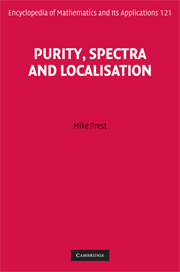Book contents
- Frontmatter
- Contents
- Preface
- Introduction
- Part I Modules
- 1 Pp conditions
- 2 Purity
- 3 Pp-pairs and definable subcategories
- 4 Pp-types and pure-injectivity
- 5 The Ziegler spectrum
- 6 Rings of definable scalars
- 7 M-dimension and width
- 8 Examples
- 9 Ideals in mod-R
- Appendix A Model theory
- Part II Functors
- Part III Definable categories
- Appendix D Model theory of modules: an update
- Appendix E Some definitions
- Main examples
- Bibliography
- Index
5 - The Ziegler spectrum
from Part I Modules
Published online by Cambridge University Press: 05 March 2013
- Frontmatter
- Contents
- Preface
- Introduction
- Part I Modules
- 1 Pp conditions
- 2 Purity
- 3 Pp-pairs and definable subcategories
- 4 Pp-types and pure-injectivity
- 5 The Ziegler spectrum
- 6 Rings of definable scalars
- 7 M-dimension and width
- 8 Examples
- 9 Ideals in mod-R
- Appendix A Model theory
- Part II Functors
- Part III Definable categories
- Appendix D Model theory of modules: an update
- Appendix E Some definitions
- Main examples
- Bibliography
- Index
Summary
The Ziegler spectrum is defined in a variety of equivalent ways. Isolation of points in closed subsets proves to be a central issue. There is a duality between the right and left spectra over any ring. Some morphisms between rings induce continuous maps between spectra. Even more use is made of functorial techniques.
The Ziegler spectrum
Section 5.1.1 introduces the Ziegler spectrum and has proofs of the basic results. Closed points are considered. Examples and some special cases are given. It is proved in Section 5.1.2 that the topology has a basis of compact open sets and that the Ziegler spectrum over any ring is compact. There is a description of the topology in terms of morphisms between finitely presented modules in Section 5.1.3.
What is now called the Ziegler spectrum is a topological space which was introduced by Ziegler in his landmark paper [726]. This space played a central role in that paper, which was concerned with the model theory of modules. For example the “support” of an elementary (= axiomatisable) class of modules is a closed subset of the spectrum and the correspondence between classes of modules and closed sets is bijective (5.1.6) when restricted to those axiomatisable classes which are closed under direct sums and direct summands (these have been called definable classes in Section 3.4.1).
- Type
- Chapter
- Information
- Purity, Spectra and Localisation , pp. 209 - 279Publisher: Cambridge University PressPrint publication year: 2009



